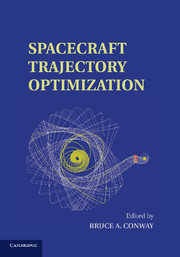Book contents
- Frontmatter
- Contents
- Preface
- 1 The Problem of Spacecraft Trajectory Optimization
- 2 Primer Vector Theory and Applications
- 3 Spacecraft Trajectory Optimization Using Direct Transcription and Nonlinear Programming
- 4 Elements of a Software System for Spacecraft Trajectory Optimization
- 5 Low-Thrust Trajectory Optimization Using Orbital Averaging and Control Parameterization
- 6 Analytic Representations of Optimal Low-Thrust Transfer in Circular Orbit
- 7 Global Optimization and Space Pruning for Spacecraft Trajectory Design
- 8 Incremental Techniques for Global Space Trajectory Design
- 9 Optimal Low-Thrust Trajectories Using Stable Manifolds
- 10 Swarming Theory Applied to Space Trajectory Optimization
- Index
- References
8 - Incremental Techniques for Global Space Trajectory Design
Published online by Cambridge University Press: 06 December 2010
- Frontmatter
- Contents
- Preface
- 1 The Problem of Spacecraft Trajectory Optimization
- 2 Primer Vector Theory and Applications
- 3 Spacecraft Trajectory Optimization Using Direct Transcription and Nonlinear Programming
- 4 Elements of a Software System for Spacecraft Trajectory Optimization
- 5 Low-Thrust Trajectory Optimization Using Orbital Averaging and Control Parameterization
- 6 Analytic Representations of Optimal Low-Thrust Transfer in Circular Orbit
- 7 Global Optimization and Space Pruning for Spacecraft Trajectory Design
- 8 Incremental Techniques for Global Space Trajectory Design
- 9 Optimal Low-Thrust Trajectories Using Stable Manifolds
- 10 Swarming Theory Applied to Space Trajectory Optimization
- Index
- References
Summary
Introduction
Multiple gravity assist (MGA) trajectories represent a particular class of space trajectories in which a spacecraft exploits the encounter with one or more celestial bodies to change its velocity vector. If deep space maneuvers (DSM) are inserted between two planetary encounters, the number of alternative paths can grow exponentially with the number of encounters and the number of DSMs. The systematic scan of all possible trajectories in a given range of launch dates quickly becomes computationally intensive even for moderately short sequences of gravity assist maneuvers and small launch windows. Thus finding the best trajectory for a generic transfer can be a challenge. The search for the best transfer trajectory can be formulated as a global optimization problem. An instance of this global optimization problem can be identified through the combination of a particular trajectory model, a particular sequence of planetary encounters, a number of DSMs per arc, a particular range for the parameters defining the trajectory model, and a particular optimality criterion. Thus a different trajectory model would correspond to a different instance of the problem even for the same destination planet and sequence of planetary encounters. Different models as well as different sequences and ranges of the parameters can make the problem easily solvable or NP-hard. However, the physical nature of this class of transfers allows every instance to be decomposed into subproblems of smaller dimension and smaller complexity.
- Type
- Chapter
- Information
- Spacecraft Trajectory Optimization , pp. 202 - 237Publisher: Cambridge University PressPrint publication year: 2010
References
- 3
- Cited by

